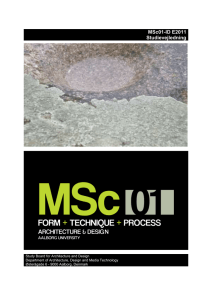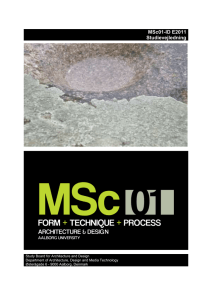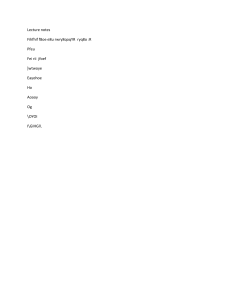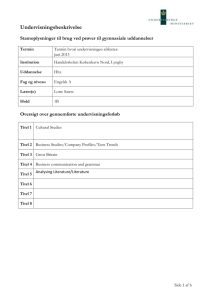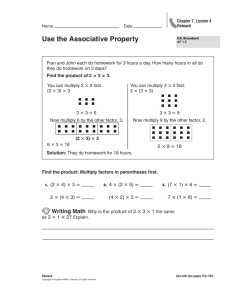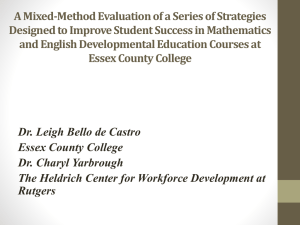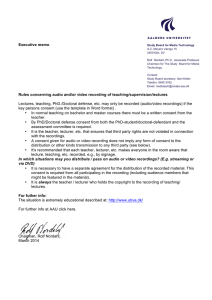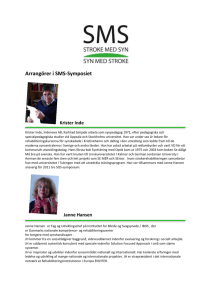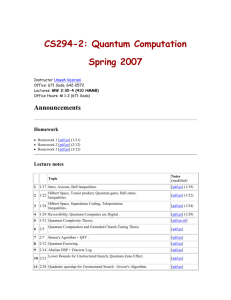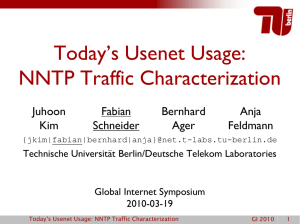List of Content
advertisement
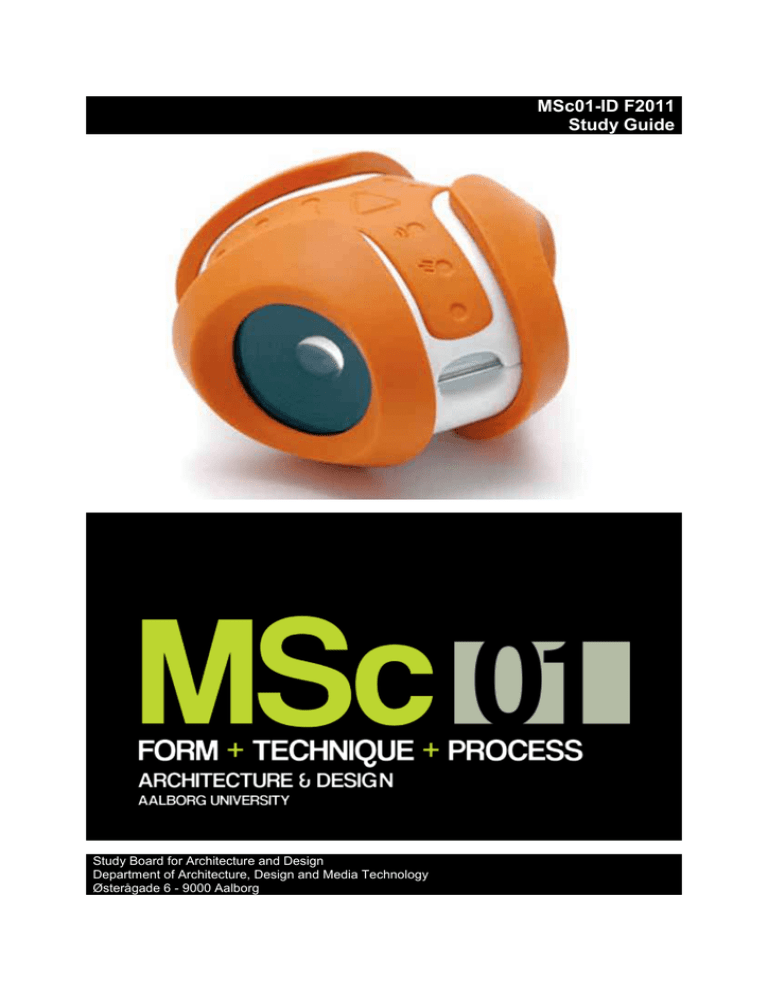
MSc01-ID F2011 Study Guide Study Board for Architecture and Design Department of Architecture, Design and Media Technology Østerågade 6 - 9000 Aalborg Studievejledning MSc01-ID E2011 List of Content 1 Velkomstbrev til studerende og undervisere ..................................Error! Bookmark not defined. 2 Semestrets modulære opbygning ...................................................Error! Bookmark not defined. 3 Tidsplan 2011 .................................................................................................................................. 6 4 Kontaktliste ......................................................................................Error! Bookmark not defined. 5 Project module 1: Scandinavian Design ......................................................................................... 9 6 5.1 Formalia .................................................................................................................................. 9 5.2 Litteratur ................................................................................................................................ 10 5.3 Aflevering ................................................................................Error! Bookmark not defined. 5.4 Prøveform................................................................................Error! Bookmark not defined. 5.5 Note ....................................................................................................................................... 11 5.6 Projektbeskrivelse: Titel ........................................................................................................ 11 Course module 1: Production and Economy ................................................................................ 14 6.1 7 Course module 2: Designing the Value ........................................................................................ 19 7.1 8 Kursusbeskrivelser ................................................................................................................ 21 Course module 3: Constructing the Detail .................................................................................... 27 8.1 9 Kursusbeskrivelser ..................................................................Error! Bookmark not defined. Kursusbeskrivelser ..................................................................Error! Bookmark not defined. Frie studieaktiviteter og studieture ..................................................Error! Bookmark not defined. 9.1 Fri studieaktivitet 1: Studietur til Italien ...................................Error! Bookmark not defined. 9.2 Fri studieaktivitet 2: Skulpturel tegning ...................................Error! Bookmark not defined. 9.3 Fri studieaktivitet 3: Matematisk Laboratorium 2 ....................Error! Bookmark not defined. 10 Bilag ............................................................................................Error! Bookmark not defined. 10.1 Bilag 1: Plagiering og korrekte referencer ...............................Error! Bookmark not defined. 10.2 Bilag 2: Retningslinjer for samarbejdsvanskeligheder ............Error! Bookmark not defined. 10.3 Bilag 3: Reeksamen ................................................................Error! Bookmark not defined. 10.4 Bilag 4: Generelle afleveringskrav ..........................................Error! Bookmark not defined. 2 Studievejledning MSc01-ID E2011 1 Welcome to students, supervisors and lecturers Welcome to 1st semester! This Study Guide is valid for the 1st semester in the Industrial Design M.Sc. program at Architecture and Design. It is preconditioned that this guide is read before or immediately after the opening of the semester by all involved students, supervisors and lecturers. The Study Guide is a supplement and elaboration of the existing curriculum’s specifications concerning the project module and the course modules. The Study Guide is a support for students, supervisors, and lecturers in relation to the planning and implementation of the project work and the individual course. The Study Guide elaborates the learning goals that are established in the curriculum related to the project module. Practical rules concerning plagiarism, exclusion of group members- re-examination and general requirements for assignment submission are placed at the end of this document as appendixes. Enjoy! Best regards, Kaare Eriksen, Semester Coordinator 3 Studievejledning MSc01-ID E2011 2 The modular construction of the Semester This semester focuses on Scandinavian Design and the challenges thereby. The semester consists of a project module (15 ECTS) and three course modules (3 x 5 ECTS). The work load for one semester is 30 ETCS corresponding 900 hours of study work for each student. The semester is conducted qua a series of project- and course modules further described in this document. The work load may vary throughout the semester and in the individual project- and course modules. It is the semester coordinator’s responsibility in cooperation with the steering committee to assure the total work load does not exceed 900 hours. Please note, free study activities are offered as a supplement to each student and does not take part of the approved curriculum. The semester consists of four modules that will be examined individually. The course modules are principally independent but together they establish a significant foundation for the semester. The planning of the semester aims to support the progression of the project module in the course modules. Project module 1: Scandinavian Design Course module 1: Production and Economy Course module 2: Course module 3: Designing the Value Constructing the Detail 15 ECTS 5 ETCS 5 ETCS 5 ETCS 7-point marking scale 7-point marking scale 7-point marking scale Pass/Fail Further information at page 9 Further information at page 14 Further information at page 19 Further information at page 27 Henceforth, course module 1 will be named PE, course module 2 DV, course module 3 CD and project module 1 SD. This semester the following free study activities are announced: Study Trip: Design Messe 3 ECTS Pass/Fail Further information at page 33 4 Studievejledning MSc01-ID E2011 3 The modular execution of the Semester The activities of the semester will NOT be prosecuted by the following procedure, as the coordinator was not able to adjust it correctly. A separate schedule draft will be attached!! September 36 37 38 October 39 40 41 42 November 43 44 45 Project module 1: Scandinavian Design W 46 47 December 48 49 M 50 51 January 52 S 1 2 A A 3 4 5 Course module 1: Production and Economy S A Course module 2: Designing the Value W W S Course module 3: Constructing the Detail W S 46 47 A ST 36 37 38 39 40 41 42 43 44 45 48 49 50 51 52 1 2 3 4 W: Workshop M: Midterm review S: Submission A: Assessment S T: Study Trip: Error! Reference source not found. Modular work load for the student. Total for a semester are 900 hours: Course module 1: 5 Lectures 10 lectures (2* 45 Production and ETCS min + 40 of Economy 150 individual study) hours Teoretical assignments Preparation Workshop 2 days (14 hours of workshop + 10 hours individual study and design) Course module 2: Designing the Value Course module 3: Constructing the Detail 5 ETCS 150 hours 5 ETCS 150 Project work Total Lectures Teoretical assignments Preparation Workshop Excurtion Project work Total Lectures 5 9 lectures (2* 45 min + 40 of individual study) Seminar 5 days (36 hours of workshop + 10 hours individual study and design) 10 lectures (2* 45 min + 40 of individual study) 17h 20 min 24 h 150 17h 20 min 46 h 150 17h 20 min 5 Studievejledning MSc01-ID E2011 hours Teoretical assignments Preparation Workshop Project module 1: Scandinavian Design 4 15 ETCS 450 hours Excurtion Project work Total Lectures Teoretical assignments Preparation Workshop Excurtion Project work Total 5 lectures (2* 45 min + 40 of individual study) 17h 20 min 4 days (28 hours of workshop + 10 hours individual study and design) 28 h 150! 3 lectures (2*45 min + 40 min of individual study) 150 h 6,5 h 450! Semester Calendar 2011 Subject to changes. Always check the semester calendar online. Minutes are required from all meetings in the steering group. A student (typically the deputy chairman) takes minutes the semester coordinator approves them before sending to the semester secretary and Study Board for Architecture and Design (adstudyboard@create.aau.dk). Date Subject, deadline, etc. 08.august 2011 Styregruppemøde 0 - Gennemgang af evaluering og planlægning af semestret 01. sep. Semesterstart – i København på CODE udstillingen BC 08. sep. kl. 13:0015:00 Gruppedannelse 8. & 9.sept Room Fællesmøder/milepæle 14.nov Statusseminar 5.& 6.sept 12.sept Studietur til Kbh: studie skandinavisk design Virksomhedsbesøg på Hagens Fjedre 30/9 & 9/11 & 6/12 Kursusmodulaflev/eksamen Semestersekretær 20/12 Projektrapport aflevering Semestersekretær 20/12 Procesrapport aflevering Semestersekretær 6 Studievejledning MSc01-ID E2011 3.januar 2012 Styregruppemøde 4 - Semesterevaluering Som ovenfor Eksamensperiode Kursusmodul 9.-13.januar 2012 Eksamensperiode Projektmodul 7 Studievejledning MSc01-ID E2011 5 List of Contacts Function Semester coordinator Semester secretary Project module 1: Scandinavian Design ECTS 15 Supervisors Person E-mail Lektor, Kaare Eriksen eriksen@create.aau.dk Kristina Wagner Røjen kwro@create.aau.dk Coordinator E-mail Lektor, Kaare Eriksen eriksen@create.aau.dk Professional competencies Contact Kaare Eriksen http://personprofil.aau.dk/pro fil/101896 eriksen@create.aau.dk ??? ??? Course module 1: Production and Economy ECTS Coordinator E-mail 5 Lektor Poul Kyvsgaard, CIP, AAU kyvs@production.aau.dk Lecturers Course module 2: ECTS Designing the Value 5 Lektor Finn K.Schou, I7, AAU fsch@create.aau.dk Coordinator E-mail Adjunkt Louise Møller Nielsen, I7,AAU lmni@create.aau.dk Lecturers Course module 3: Constructing the Detail Lektor Poul Kyvsgaard, CIP kyvs@production.aau.dk Lektor Finn Kehlet Schou, I7, AAU fsch@create.aau.dk ECTS Coordinator E-mail 5 Lektor Kaare Eriksen, I7, AAU eriksen@create.aau.dk Lecturers Lektor Finn Kehlet Schou, I 7, AAU Lektor xx, I 9, AAU Flemming Christiansen, SP 8 fsch@create.aau.dk Studievejledning MSc01-ID E2011 6 Project module 1: Scandinavian Design 15 ETCS Skandinavisk Design Scandinavian Design is the theme of the semester and through the courses and projects the students are getting closer to understanding the qualities of Danish design and how to design products for a Danish company with an international market. The semester is also focusing on ways to ensure that a company can strenghten its value chain and strategic potential by new products that are well designed, technologically up to date and connected to the company values and the needs of the user. 6.1 Formalities Curriculum p. 56 Prerequisites A BSc degree (Bachelor) i Architecture and Design or similar Objective The aim of the project is to enable students to work professionally in a design process in collaboration with a client (company) to achieve a professional design proposal in coherence with predefined targets and criteria. Students who complete the module: Knowledge Must be able to explain and argue for the chosen production methods and tools in relation to the manufacturer’s market position, culture and capabilities Must be able to account for the main experiments, tests, proposals and evaluations affecting the decision-making in the design process Must be able to account for the main critical issues in the design proposal and the appropriate course of action to amend these Must be able to account for the scientific validity of test, investigations and other type of data used in the design process Skills Must be able to identify relevant research and communicate the product context and target group of a chosen subject Must be able to create a design brief stating the objectives of the design proposal Must be able to transfer and translate knowledge elicited from the users to visions, specifications and revisions before and during the development process Must be able to estimate market potential, retail price point and determine the target cost of production per unit Must be able to research, explain and evaluate the main technology used in the product design or manufacturing process in the project Must be able to utilise the relevant 2 and 3 dimensional analogue and digital tools to generate design proposals depending on the specific focus at a given time throughout the design process Competencies Must be able to generate an innovative product proposal and be able to design and detail central components, estimate market potential and production costs for a given number of units and present them in a manner that enables a client to decide whether or not to go forward with the proposal Must be able to design an innovative product that integrates aesthetical 9 Studievejledning MSc01-ID E2011 considerations with form and functional aspects that appeal to the target group. The student must also be able to ensure that construction and production costs do not exceed the specified price and that the product’s appearance, market position and overall presentation are in keeping with the company brand. 6.2 Litteratur Primær litteratur Angiv semesterrelevant litteratur. Primær litteratur er det obligatoriske. Husk at angive sidetal/kapitler. DETTE MANGLER ENDNU! Sekundær litteratur Her angives øvrige kilder, undervisers publikationer mm. DETTE MANGLER ENDNU! 6.3 Submision Krav Der afleveres en Projektrapport, som består af 2 dele, nemlig en Procesrapport og en Produktrapport for beskrivelse af projektets forløb og resultater. I Procesrapporten redegøres for projektets mål, vægtning, organisering og forløb, samt beskrivelser og reflektioner over anvendte metoder og teorier. Desuden beskrives beregninger og data fra undersøgelser og forsøg, ligesom der reflekteres over deres indflydelse på det konkrete projektforslag og processen som helhed. Dele heraf eventuelt i bilag til Procesrapporten. Max. 100 sider I Produktrapporten gives en præsentation af det konkrete produktforslags æstetik, brug og konstruktion, samt relevante forhold om produktets kontekst og detaljer. Produktrapporten, eller dele heraf skal desuden simulere et forhandlings- eller salgsmateriale for relevant virksomhed eller investorkreds. Max 25 sider Principielt forventet indhold af Proces- og Produktrapport gennemgås og diskuteres på et indledende fællesmøde med deltagelse af semesterholdets studerende og vejleder/e Relevante modeller vedrørende konstruktion, funktion, æstetik og brug medtages til eksamen sammen med relevant dokumentation fra proces og udviklingsforløb. Ved eksaminationen medbringes desuden en Projektplanche (størrelse A0 portrætformat) opklæbet på skumpap, der illustrerer projektets ide og resultater på en måde, så projektets væsentligste kvaliteter er forståelige og indbydende ved ophængning på offentlig udstilling som studieårsudstilling eller lignende.Umiddelbart efter eksamen afleveres planche til semestersekretær. Planchen skal indeholde følgende data: Navn Semester År Projekttitel Synopsis Sammendrag af projektet min. 300 ord Illustrationer. Dato 20. december 2011 ved semestersekretær. Projektplanche umiddelbart efter eksamen til semestersekretær 6.4 Assessment 10 Studievejledning MSc01-ID E2011 Version E2 – Main project module, external examination The module is assessed by an oral exam based on written material, typically a jointly prepared (or in exceptional cases, prepared by the individual student) project module report (containing the report/analyses/posters/drawings/models or similar). It is further presumed that the student has regularly and actively participated in evaluation seminars and the like. The project is concluded with a project closing of max. 45 min. It is a precondition for participation in the examiniation that students have participated in the project closing. The entire project is presented with equal participation of all the group members. The starting point for the examination is the project report and the project closing presentation, cf. Examination Policies and Procedures: http://www.teknat.aau.dk/digitalAssets/18/18291_eksamensordning-_engelsk.pdf) The allotted time for assessment is in practice 20-30 min. per examinee depending on group sizes, as there must be time for voting. The starting point of the exam is the evaluation criteria as they appear in the curriculum and this study guide. The assessment is based on a combined evaluation of the report and the oral performance. Examiner and external examiner are involved in the assessment along with the examinee. Grading is according to the 7-point marking scale. 6.5 Note Det forventes, at studerende i forbindelse med projektenheden sørger for i fællesskab at arrangere transport i forbindelse med virksomhedsbesøg og den lindledende studietur til København. 6.6 Project Description: Scandinavian Design Content and Theme Scandinavian Design Projektmodulet Scandinavian Design har blandt andet til hensigt at træne professionelt samarbejde gennem udarbejdelse af et konkret designprojekt for en skandinavisk virksomhed, hvor den enkelte projektgruppe simulerer tegnestue og ekstern konsulent for klientvirksomheden. I efteråret 2011 samarbejdes med virksomheden Hagens Fjedre i Støvring, Nordjylland, som er underleverandør til producenter og forhandlere indenfor en lang række produktkategorier. Hver projektgruppe udvælger en sådan produktkategori, udarbejder designbrief og designer en produktserie, hvortil Hagens kan indgå strategisk i værdikæden. Produktserien udvikles på baggrund af relevante undersøgelser og forsøg og i løbende modellering og skitsering med relevante medier. Gruppens valg af kategori besluttes i samråd med vejleder for at sikre, at produktet giver tilstrækkelig tekniske og designmæssige udfordringer. Produktets relation til det valgte marked udvikles, ligesom der udarbejdes forslag til værdikæder og forretningsmodeller i forhold til Oestwalds strategilærred. Der udarbejdes digitale visualiseringer og dokumentation af betydende løsninger for tekniske problemer i konstruktionen, såsom sammenføjnings eller funktionsproblematikker, ligesom materiale- og procesvalg og æstetisk/semiotiske dispositioner beskrives og argumenteres. Der foretages analyser af produktionspris og optimering heraf for mindst én betydende produktkomponent, ligesom der udarbejdes et selvstændigt afsnit i procesrapporten, som redegør for en teknologisk problematik, som gruppen selvstændigt er gået i dybden med. 11 Studievejledning MSc01-ID E2011 Instruction Selve projektforløbet startes allerede i semestrets begyndelse i umiddelbar forlængelse af studie tur til København. De første kursusmoduler sættes således først for alvor i gang efter de indledende manøvrer, hvor projektmodulets struktur og principper fastlægges efter analyser af tilsvarende projekter i samarbejde med hoved- og bivejledere. Der gennemføres tillige fælles besøg hos samarbejdsvirksomheden, hvor virksomhedens produktion observeres, og projektets problematikker uddybes og afklares i dialog mellem de studerende og virksomhedens kontaktmedarbejdere. På denne baggrund udarbejdes et designbrief, som indkredser projektopgavens mål og retning. Projektforløbet, som ellers strækker sig over flere måneder, afbrydes herefter af kurser, der ligger på hverdage undtaget projektdagene, som typisk ligger på mandage, men også i hele uger, hvor det er muligt at arbejde med projektdelen. Det tilstræbes, at der udarbejdes et digitalt logbogssystem for de enkelte grupper, hvor det er muligt for projektvejledere at følge med i de enkelte gruppers arbejde og give løbende digital feed-back udover aftalte vejledermøder. Der afholdes i forløbet mindst eet fælles statusseminar, hvor samarbejdsvirksomheden deltager. Læringsmål/ Problembaseret projektarbejde Angående semesterets læringsmål: Se studieordningsteksten ovenfor Metode Der anvendes en projekt- og problembaseret projektarbejde, som understøttes af en række projektenheder, der dog eksamineres selvstændigt, Da baggrunden for optagelse på semesteret er en bacheloruddannelse med både teknisk og designmæssigt udviklingsorienteret indhold, forventes det, at der arbejdes med metoder, der hentes fra såvel det tekniske som det designmæssigt faglige område. På semesteret introduceres endvidere en række metoder, der typisk kendes fra virksomhedsledelse og det merkantile område, og det forventes at de studerende gruppevis selv er i stand til at udvælge og anvende metoder, der passer til de løbende hoved- og underproblematikker, de møder i forsøget på at formgive et produkt og dets produktplatform. Det forventes i udpræget grad, at de studerende er i stand til at anvende en designmetodisk tilgang, som i en klassisk’ industriel design’ forståelse betyder en løbende simultan bearbejdning af hoved- og delproblematikker indenfor såvel kontekst, brug, æstetik, funktion og produktionsforhold. Ydermere forventes det, at de studerende er i stand til at anvende relevante ingeniørfaglige metoder og modeller for udvikling og evt. optimering af særlige tekniske områder i relation til projektopgaven. Og at de som universitetsstuderende er i stand til at reflektere over eget virke og medvirke til områdets faglige opbygning genne, øvelser og projekter. Hovedparten af semesterets studerende er trænet i projektorienteriet gruppearbejde, og det forventes at de studerende i procesforløbet videreudvikler deres evne til gruppeprojektsamarbejde, og især at det sikres, at den enkelte træner kompetencer, som trænger til at forbedres. Udenlandske studerende, som ikke har arbejdet på denne måde i eget bachelorforløb har sandsynligvis gennemgået et introducerende PBL-forløb i ugen før studiestart. Disse studerende bliver delt jævnt ud på grupperne for at sikre den bedste synergi. Lectures Following lectures will be a part of the project module: Lecture 1: Lecturer and format Name Course format: Lecture 12 Studievejledning MSc01-ID E2011 Information Literature Lecture 1: Lecturer and format Name Course format: Lecture Information Literature Lecture 1: Lecturer and format Name Course format: Lecture Information Literature 13 Studievejledning MSc01-ID E2011 7 Course module 1: Production and Economy 5 ETCS Produktion og økonomi Coordinator Formalities Curriculum p. 54 Assofciate Prof., Poul Kyvsgaard Hansen, Center for Industrial Production, AAU Prerequisites A BSc degree (Bachelor) i Architecture and Design or similar. Objective The aim is to enable students to acquire a business perspective on design and production so that they are capable of creating a design which demonstrates an understanding of the relationship between markets, production costs, construction and the configurations of products (platforms/families). Students who complete the module: Knowledge Must have basic knowledge of the relationship between prices and features of the materials traditionally used in manufacturing Must have knowledge of the cost and effort involved in various ways of constructing, assembling and manufacturing products and product components Must be able to demonstrate knowledge of central theories and methods used in product families and product platforms Must have knowledge of the theories and methods of project management and of the financial aspects of product development (e.g. budgeting) Must have knowledge of basic technology and market scanning tools, basic methods for carrying out trend and competitor analysis and of the market-specific relation between cost of production and retail price point Skills Must be able to give a rough estimation of production costs of a given product Must be able to decide, argue and explain in detail the relationship between the design of the proposed method of construction, assembly and production and its market potential and price point. And subsequently account for the implications for these of any changes in design Competencies Must be able to argue for the relationship between retail price and expected sales (in units) of a given product. And from this specify the maximum acceptable production costs Must be able to design and construct a simple product within a given price point using specified materials, production methods/processes and assembly methods Submission Content Portfolio with individual reflections from lectures 1-9 (max 10 pages) A focused paper elaborated as a reflection of the 1-3 themes covered in the last three lectures 10-12 (min 4 pages). Requirements Turned in in three copies to the study secreatry Date 14 Studievejledning MSc01-ID E2011 Assessment Instruction Content One week after last lecture Version D – Course module The module is assessed with an oral exam based on written material prepared by the individual student such as a portfolio presentation or a (possibly jointly prepared) project module report (containing the report/analyses/posters/drawings/models or similar). It is further presumed that the student has regularly and actively participated in evaluation seminars. The course consists of lectures with exercises. The last three lectures will be organized as workshops with outset in integrated themes from the first 9 lectures. The course consists of 12 lectures. The first 9 lectrues will present various engineering methods and tools. The last 3 lectures will be designed as workshops that mix the former methods and tools in various industrial cases. The last 3 lectures will provide the foundation for a focused paper (min 4 pages) that will be a part of the individual examination. 7.1 Course Descriptions Note The literature for the course will be distributed as pdf-notes Course 1 Introduction Instruction Lecture with exercise Lecturer Associate. Prof. Poul Kyvsgaard Hansen, Center for Industrial Production, AAU Content Setting the scene. The introductory lecture of the course will be focusing on defining the parameters that determine the cost and economy aspects of product development and production. The keywords are: cost, price, value, value chain, configuration Literature Primary Literature There is no primary literature for this first session Course 2 Cost in a narrow sense Instruction Lecture with exercise Lecturer Asc. Prof. Poul Kyvsgaard Hansen Center for Industrial Production, AAU 15 Studievejledning MSc01-ID E2011 Content Literature Cost in a narrow sense is the basic cost that can be associated with a component. This cost is typically the cost that a company will estimate when evaluating design choices. The lecture will focus specifically on injection moulding and the goal is to qualify the participants to be able to estimate a cost for a given plastic component. Primary Literature Note: Calculation of Plastic Moulding Components Secondary Literature Excel Spread Sheet program to support parameter estimation Excel Spread Sheet program to support economical estimations Course 3 Price and value Instruction Lecture with exercise Lecturer Asc. Prof. Poul Kyvsgaard Hansen, Center for Industrial Production, AAU Content Price and value is closely related. Price understood as the price a customer is willing to pay for a product or service and value understood as the perceived value of a given product or service. The value will often be related to a specific value chain and the lecture will be focusing on establishing a number of conceptual relationships between price, value, and value chains. Literature Primary Literature Richard Normann and Rafael Ramírez: From Value Chain to Value Constallation: Designing Interactive Strategy, Harvard Business Review, July-August, 1993 Secondary Literature Poul Kyvsgaard Hansen: Valuechains in 3D, CIP, 2011 Course 4 Value and innovation Instruction Lecture with exercise Lecturer Asc. Prof. Poul Kyvsgaard Hansen, Center for Industrial Production, AAU Content Creating value is a design parameter that is determined by an organization’s innovation capability. The lecture will focus on innovation focus and innovation capability and will introduce a comprehensive concept that enable an organization to focus innovation efforts. Literature Primary Literature David Francis and John Bessant: Targeting innovation and implications for capability development, Technovision, Spring 2004 W. Chan Kim and Renée Mauborgne: Blue Ocean Strategy, Harvard Business Review, October 2004. Secondary Literature . 16 Studievejledning MSc01-ID E2011 Course 5 System approach and system analysis Instruction Lecture with exercise Lecturer Asc. Prof. Poul Kyvsgaard Hansen, Center for Industrial Production, AAU Content System approach and system analysis can be seen as fundamental disciplines in various engineering fields. Each field tend to have their own perception of a system approach. In this lecture the focus will be on approaches from the production and product development field. Literature Primary Literature Jens Ove Riis: Models for Company Development, Doctoral Dissertation, Center for Industrial Production, Aalborg University, 2009, page 25-57 Secondary Literature Günter Ropohl: Philosophy of Socio-Technical Systems, PHIL & TECH 4:3 Spring 1999. Course 6 Parameter analysis Instruction Lecture with exercise Lecturer Asc. Prof. Poul Kyvsgaard Hansen, Center for Industrial Production, AAU Content Every product or service will have parameters that determines the functionality and efficiency in use. Furthermore, these focused parameters determine the competitiveness in a given marked. This lecture builds on lecture 4 and lecture 5. The lecture will focus on the analysis and choice of parameters for given products and services on given markets. Literature Primary Literature Dahan & Hauser: Dispersed Product Developme, Center for Business at MIT, 2000. Secondary Literature Excel Spread Sheet programes to support parameter analysis. Course 7 Product architectures and modularization Instruction Lecture with exercise Lecturer Asc. Prof. Poul Kyvsgaard Hansen, Center for Industrial Production, AAU Content The product architecture can be defined as the overall structure of a product or a product family. In many cases the product architecture has been defined in partly unconscious ways and thereby created limitations in the ways the product or service can be customized or developed further. The lecture will focus on various ways of determining, analysing and communication a specific product architecture. Literature Primary Literature 17 Studievejledning MSc01-ID E2011 Karl Ulrich: The role of product architecture in the manufacturing firm, Research Policy (24), 1995 Secondary Literature Various industrial cases Course 8 Modular platforms Instruction Lecture with exercise Lecturer Asc. Prof. Poul Kyvsgaard Hansen, Center for Industrial Production, AAU Content Modular platforms is derived from modular architectures. However, platforms tends to be a broader concept that cover both manufacturing, sales and marketing. The lecture will present several different ways of defining platforms. Literature Primary Literature Ron Sanchez: Modular architectures in the marketing process, Journal of Marketing, Vol. 63, 1999 Secondary Literature Various industrial cases. Course 9 Applied platforms and modular architectures Instruction Lecture with exercise Lecturer Asc. Prof. Poul Kyvsgaard Hansen, Center for Industrial Production, AAU Content Literature Primary Literature Charles Fine: Clockspeed-based strategies for supply chain design, Production and Operations Management, Vol 9, No. 3, 2000 Secondary Literature Various industrial cases. Course 10-12 Workshop 1, 2 and 3 Instruction Workshops based on cases Lecturer Asc. Prof. Poul Kyvsgaard Hansen, Center for Industrial Production, AAU Content The workshops will combined the former topics as presented in the course in workshop settings. Literature Primary Literature Relevant literature from the prior lectures. Secondary Literature 18 Studievejledning MSc01-ID E2011 Various industrial cases. 8 Course module 2: Designing the Value 5 ETCS Design af værdien Coordinator Louise Møller Nielsen, Assistant Professor, Department of Architecture, Design & Media Technology Formalities Curriculum p. 53 Prerequisites A BSc degree (Bachelor) in Architecture and Design or similar Objective The aim is to familiarise students working professionally in the Scandinavian context with the theories, tools and methods required for the pre-product development phase in which the focus is on what to design and why in terms of specifying both product and target group. Students who complete the module: Knowledge Must have knowledge of the history and culture of Scandinavian design Must understand, and be able to describe and explain a range of useroriented methods, which are applied to establish the basis of projects and to verify and test assumptions made during the design process Must understand and be able to explain ways of segmenting and profiling users from both user-centred design and marketing perspectives Must be able to account for the type of knowledge created by using various user- and market-oriented research methods Must have extensive knowledge of the design process and be able to explain the various approaches and phases of the design process Must have knowledge of how to define the value base and business proposition of a given design concept Skills Must be able to apply user and market research and segmentation methods to establish specifications and success criteria Must be able to describe product specifications, practical and theoretical market positioning and presentation as part of the branding and communication of the product Must be able to rapidly conceptualise and roughly sketch a product on the basis of a set of defined values, including the principles which lie behind its aesthetic expression, use and construction Competencies Must have the ability to select and apply appropriate user-centred design and market research methods depending on the type of knowledge required for the design of a product Must be able to define a clear value basis and business case for a product to be developed, and to position and present the product accordingly Literature Primarr literature Sanders L (2006) Design Research in 2006 Design Research Quarterly Vol.1, No. 1, p. 1-8 19 Studievejledning MSc01-ID E2011 Munnecke M & Van der Lugt R (2006) Bottom-up strategies in consumer- led markets. Second international Seville seminar on Future-Orient ed Technology analysis: Impact if FTA approaches on policy and decision making. Seville: September 28-29 Page 85+93 in "Value and Vision-based methodology in Integrated Design",Tollestrup, 2004, Ph.D Thesis, AAU. Osterwalder A (2009) Business Model Generation, Self Published, ISBN: 978-2-8399-0580-0, pp 14-51+128-195, LIEBERMAN, M. B. & MONTGOMERY, D. B. 1988. First-Mover Advantages. Strategic Management Journal, 9, 41-58. SCHOU, F. K. 2007. Towards Digital Integration: Platform Thinking in the Fashion Business. In: HÖRLESBERGER, M., EL-NAWAWI, M. & KHALIL, T. (eds.) Challenges in the Management of New Technologies. Singapore: World Scientific Publishing Co. Pte. Ltd. Sekundær litteratur Cooper R & Evans M (2006). Breaking from Tradition: Market Research, Consumer Needs, and Design Futures Design Management Review Vol. 17, p. 6876 Chapter 4 in "Staging for creative collaboration", Lerdahl, 2001, Ph.D Thesis, NTNU. Osterwalder A (2009) Business Model Generation, Self Published, ISBN: 978-2-8399-0580-0, pp 52-119 The books below are for inspiration - they do not have to be read from cover to cover! Rosted J, Lau T, Høgenhaven C & Johansen P (2007) Concept design – how to solve complex challenges of our time FORA: Copenhagen, Denmark (available at: http://www.ebst.dk/file/7661/conceptdesign.pdf) Kim, W. Chan, and Mauborgne, Renee. Blue Ocean Strategy. How to Create Uncontested Market Space and Make Competition Irrelevant. Boston: Harvard Business School Press. 2005. Submission Content Each student must hand-in 3 A3 posters Poster no. 1 must show the result from the workshop: Vision-based methodology (Course 2+3). Poster no. 2 must show the result from the workshop: Generating Business Models (Course 8-10) Poster no. 3 must show the result from the workshop: Evaluating and managing business models (Course 12) Requirements Hand- in: A digital version (pdf.) oploaded to the semester secretary Exam: 2 set (2 x 3 posters) printed, which the student bring to the exam 20 Studievejledning MSc01-ID E2011 Date 14:00 (2 p.m.) 29th of september 2011 Opload at: \\create.aau.dk\Studies\master-1sem\ID\Autumn 2011\Hand-in Designing the value Assessment Instruction Content Version D – Course module The module is assessed with an oral exam based on written material prepared by the individual student such as a portfolio presentation or a (possibly jointly prepared) project module report (containing the report/analyses/posters/drawings/models or similar). It is further presumed that the student has regularly and actively participated in evaluation seminars. 6 Lectures 1 Lecture & workshops 5 Workshops The course consist of 12 units – divided into three blocks. In the first 3 units some of the basic elements for designing the value are introduced. This includes a framework for user-and market research as well as the introduction to a methodology for creating value missions. The next 7 units focus on business model generation. In other words: transforming user/costumer insights into operational business models. The last 2 units focus on the strategic- and organizational environment around business models and the evaluation of business models. Each block consist of both lectures and workshops, and each block will be part of the evaluation. 8.1 Course 1 Instruction Lecturer Content Kursusbeskrivelser Designing the value – user and market research Lecture Louise Møller Nielsen, Assistant Professor, Department of Architecture, Design & Media Technology The objective in this lecture is to introduce a framework for user- and market oriented methods. The framework shows the differences and overlaps of the two approaches - in terms of the knowledge they create and how they can be applied in the development of new offerings. The framework further shows why it is relevant to segment and profile users from both user-centred design and marketing perspectives. Furthermore, the lecture introduces participatory design, which is fundamental to the Scandinavian design tradition. 21 Studievejledning MSc01-ID E2011 Literature Primary Literature Sanders L (2006) Design Research in 2006 Design Research Quarterly Vol.1, No. 1, p. 1-8 Munnecke M & Van der Lugt R (2006) Bottom-up strategies in consumer- led markets. Second international Seville seminar on Future-Orient ed Technology analysis: Impact if FTA approaches on policy and decision making. Seville: September 28-29 Secondary Literature Cooper R & Evans M (2006). Breaking from Tradition: Market Research, Consumer Needs, and Design Futures Design Management Review Vol. 17, p. 6876 Course 2 Instruction Lecturer Content Literature Introduction to Vision-based methodology and creating Value Mission Lecture & workshop Christian Tollestrup, Associate Professor, Department of Architecture, Design & Media Technology The objective of this lecture is to show a methodology creating a value mission for instance on the base of user and market research. The module introduces the Vision-based methodology, the underlying theory and cases of using the methodology. The main milestones of Value-mission and Interaction vision are explained. Start up on creating the content of a Value Mission. Exercises and facilitation on group level. Primary Literature Page 85+93 in "Value and Vision-based methodology in Integrated Design",Tollestrup, 2004, Ph.D Thesis, AAU. (recommended literature) Secondary Literature Chapter 4 in "Staging for creative collaboration", Lerdahl, 2001, Ph.D Thesis, NTNU. (optional literature) Course 3 Instruction Lecturer Content Literature Concepts, Vertical movement and Alignment Workshop Christian Tollestrup, Associate Professor, Department of Architecture, Design & Media Technology Generating product ideas, either derived from research, values or through random idea generating techniques. Deriving characteristics and qualities that would define the Interaction Vision of the product without describing features and functions. Exercise in aligning content on 4 levels of abstraction. Primary Literature Literature: 85, 87, 89, 91, 94, 96 and 97. in "Value and Vision-based methodology in Integrated Design",Tollestrup, 2004, Ph.D Thesis, AAU. (recommended literature) 22 Studievejledning MSc01-ID E2011 Course 4 Instruction Lecturer Content Literature Business Model Generation Lecture Louise Møller Nielsen, Assistant Professor, Department of Architecture, Design & Media Technology The objective of this lecture is to position the user research and value missions in the context of business models. The lecture introduces tools for hand-on bussiness model generation. This is done on the basis of Alexander Osterwalder’s business model generation canvas. The lecture also includes a number of business model cases, which underlines the use of the canvas. Primary Literature Osterwalder A (2009) Business Model Generation, Self Published, ISBN: 978-2-8399-0580-0, pp 14-51 Secondary Literature Osterwalder A (2009) Business Model Generation, Self Published, ISBN: 978-2-8399-0580-0, pp 52-119 Course 5 Instruction Lecturer Content Literature Business Models in Practice I Lecture Poul Kyvsgaard, Associate Professor, Center for Industrial production The objective of this lecture is to introduce business cases from small and medium size companies, and allow the student to analyze existing business models by using Osterwalder’s Business Model Generation Canvas. Primary Literature Osterwalder A (2009) Business Model Generation, Self Published, ISBN: 978-2-8399-0580-0, pp 14-51 Secondary Literature Osterwalder A (2009) Business Model Generation, Self Published, ISBN: 978-2-8399-0580-0, pp 52-119 Course 6 Instruction Lecturer Content Literature Business Models in Practice II Lecture Finn Schou, Associate Professor, Department of Architecture, Design & Media Technology This lecture gives practical examples on how Danish SMC´s within the fashion business (design of eyewear) use a variety of internal and external resources and technologies to adapt to extreme rapid moving market Primary Literature LIEBERMAN, M. B. & MONTGOMERY, D. B. 1988. First-Mover Advantages. 23 Studievejledning MSc01-ID E2011 Strategic Management Journal, 9, 41-58. SCHOU, F. K. 2007. Towards Digital Integration: Platform Thinking in the Fashion Business. In: HÖRLESBERGER, M., EL-NAWAWI, M. & KHALIL, T. (eds.) Challenges in the Management of New Technologies. Singapore: World Scientific Publishing Co. Pte. Ltd. Course 7 Instruction Lecturer Content Literature The process of business model generation Lecture Louise Møller Nielsen, Assistant Professor, Department of Architecture, Design & Media Technology This lecture introduces and discusses different ways of generating business models, and compares the generation of business models with the process of designing products. Primary Literature Osterwalder A (2009) Business Model Generation, Self Published, ISBN: 978-2-8399-0580-0, pp 128-195 Secondary Literature Rosted J, Lau T, Høgenhaven C & Johansen P (2007) Concept design – how to solve complex challenges of our time FORA: Copenhagen, Denmark (available at: http://www.ebst.dk/file/7661/conceptdesign.pdf) - This book is inspiration - it does not have to be read from cover to cover! Course 8 Instruction Lecturer Content Generating business models I Workshop Louise Møller Nielsen, Assistant Professor, Department of Architecture, Design & Media Technology The workshop facilitates student generation of business models. It helps the students to follow the guidelines included in Osterwalder’s Business Model Generation methodology, as well as encourage the students to test different alternatives techniques from the design process – in the process of generating business models. This part of the workshop focuses on costumer insights and ideation. Literature Primary Literature Osterwalder A (2009) Business Model Generation, Self Published, ISBN: 978-2-8399-0580-0, pp 126-145 Course 9 Generating Business Models II Instruction Lecturer Workshop Louise Møller Nielsen, Assistant Professor, Department of Architecture, Design & Media Technology 24 Studievejledning MSc01-ID E2011 Content The workshop facilitates student generation of business models. It helps the students to follow the guidelines included in Osterwalder’s Business Model Generation methodology as well as encourage the students to test different alternatives techniques from the design process – in the process of generating business models. This part of the workshop focuses on visual thinking and prototyping. Literature Primary Literature Osterwalder A (2009) Business Model Generation, Self Published, ISBN: 978-2-8399-0580-0, pp 146-169 Course 10 Generating Business Models III Instruction Lecturer Content Workshop Louise Møller Nielsen, Assistant Professor, Department of Architecture, Design & Media Technology The workshop facilitates student generation of business models. It helps the students to follow the guidelines included in Osterwalder’s Business Model Generation methodology as well as encourage the students to test different alternatives techniques from the design process – in the process of generating business models. This part of the workshop focuses on storytelling and scenarios. Literature Primary Literature Osterwalder A (2009) Business Model Generation, Self Published, ISBN: 978-2-8399-0580-0, pp 170-199 Course 11 Strategy – and the organisational environment surrounding business models Instruction Lecturer Content Literature Lecture Louise Møller Nielsen, Assistant Professor, Department of Architecture, Design & Media Technology The lecture introduces the strategic issues and environment surrounding business models. The lecture provides insights in how to evaluate and manage business models, as well as understanding the business model in strategic perspectives such as ‘blue ocean’. Primary Literature Osterwalder A (2009) Business Model Generation, Self Published, ISBN: 978-2-8399-0580-0, pp 200-243 Secondary Literature Kim, W. Chan, and Mauborgne, Renee. Blue Ocean Strategy. How to Create Uncontested Market Space and Make Competition Irrelevant. Boston: Harvard Business School Press. 2005. This book is inspiration - it does not have to be read from cover to cover! Course 12 Evaluating and managing Business models 25 Studievejledning MSc01-ID E2011 Instruction Workshop Lecturer Louise Møller Nielsen, Assistant Professor, Department of Architecture, Design & Media Technology Content The workshop give the students hands-on tools to evaluate the business models, they have generated/created in the previous workshops. Literature Primary Literature Osterwalder A (2009) Business Model Generation, Self Published, ISBN: 978-2-8399-0580-0, pp 200-243 26 Studievejledning MSc01-ID E2011 9 Course module 3: Constructing the Detail 5 ETCS Konstruktion af detaljen Coordinator Associate Professor, Department of Architecture, Design and Mediatechnology, Kaare Eriksen Formalities Curriculum p. 54 Prerequisites A BSc degree (Bachelor) i Architecture and Design or similar. Objective The aim is to enable students to acquire advanced skills in integrating aesthetics, form and construction in the design of products and product elements. Students who complete the module: Knowledge Must have knowledge of the main construction and production methods including the use of tools Must have knowledge of theories of semiotics and product semantics. Must be able to understand and explain aesthetics, semiotics and product semantics in relation to a product proposal Must have knowledge of the visual and technical communication required in a product development process Skills Must be able to communicate form, materials and construction in design proposals using both analogue and digital tools Must be able to design and give form to an object and account for the relation between product semiotics, intended expression and actual construction of a product (or part thereof) Must be able to construct physical models taking into account mechanical and structural issues related to function, durability and production Competencies Must be able integrate aspects of aesthetics, form and construction into the detailed design of a product Literature Primary Literature Angiv semesterrelevant litteratur. Primær litteratur er det obligatoriske. Husk at angive sidetal/kapitler. DETTE MANGLER ENDNU! Secondary Literature Her angives øvrige kilder, undervisers publikationer mm. DETTE MANGLER ENDNU! Submission Content Hver studerende udarbejder en kursusrapport, der er opdelt i 3 dele på hver en A3-side svarende til de 3 kursustemaer. Disponeringen af kursusrapportens enkelte dele instrueres ved starten af hver del. Requirement Kursusrapporten uploades digitalt og indleveres i 3 stk A3-print, som der eksamineres i 27 Studievejledning MSc01-ID E2011 Dato Eksempel: 1. september 2011 ved semestersekretær. Assessment Version B – Course module The module is passed with approval of the individual course report submitted. One part (1-3) of the course report is chosen randomly for oral examination, and the student is examined on the basis of their ability to explain and perspectivize the content in relation to the learning objectives of the semester. Instruction Content Dette kursus har et så bredt fokus, at det også indholdsmæssigt når rundt om både teknisk/konstruktive og æstetiske elementer koblet med analyser af produktdesign i praksis og mindre øvelser. Kurset fokuserer især på de designmæssige udfordringer, der ligger i detaljens bearbejdning og samspillet med helheden. Kurset har groft set 3 hovedafsnit: 1. Danish Detail 2. Konstruktion – observation og simulering 3. Projektunderstøttende Workshop 1. Danish Detail afvikles som et 6 dages forløb, hvor de studerende på de 2 første dage forventes at deltage i pasningen af A&D’s stand på CODE 2011 i Bella Centeret, København, hvor A&D-studerendes projekter udstilles den 1. og 2.september. Den tredje og fjerde dag er afsat til forelæsning på Dansk Design Center i København, og registreringer på udstillingen ”Denmark by Design”, samt besøg på designvirksomheder i hovedstaden med oplæg om temaet ”Devil in the Detail”. Der stilles individuelle opgaver som løses af de studerende på messen og ved de efterfølgende udstillings- og tegnestuebesøg, og de individuelle observationer samles til et ’Danish Detail’ – notat. Den femte dag er afsat til selvstændigt arbejde med at færdiggøre ”Danish Detail”notater. Den 6.dag, som ligger 3 uger senere, gennemføres et heldagsworkshop, hvor holdets samlede observationer om konstruktive og æstetiske forhold diskuteres med faglig bistand af kursusholder/e 2. Konstruktion – observation og simulering I dette 5 dages forløb arbejdes konkret med at simulere konstruktive forhold i forbindelse med plastkonstruktioner. Teori, metoder og redskaber for simulering med både digitale og fysiske modeller i forskellige skalaer præsenteres ,hvorefter de studerende observerer plastemner i mindre grupper og afprøver metoder for forbedring eller optimering af fysiske og konstruktive egenskaber. Afslutningvis skitseres muligt redesign af detalje fra plastemne eller dele heraf. 3.Projektunderstøttende opsamlingsworkshop (POW) Til dette 4 dages forløb, hvori indgår eksamination i det samlede kursusmodul, etableres en række workshops, hvor studerende i samarbejde med vejlederteamet giver mulighed for fordybelse i generelle metodikker, teorier og redskaber eller særlige områder, som knytter sig til et specifikt projektfokus. OW’en sigter på dels at skabe videnspredning mellem de studerende indbyrdes og dels at indhente specialister indenfor et udvalg af udvalgte relevante emner, såsom beregningsmæssige, visualiseringstekniske eller formmæssige forhold. 28 Studievejledning MSc01-ID E2011 9.1 Course Descriptions Note De studerende forventes at deltage i studieturen til København, idet de studerende selv sørger for praktiske forhold i den forbindelse. Studerende, som ikke kan rejse for at deltage i denne del af kurset, kan løse en parallel opgave med identisk indhold og samme evalueringskriterier. Course 1 Danish Design Centre Instruction Lecture and exercise given by semester coordinator, Kaare Eriksen At Medicinhistorisk Museum, Bredgade, København Lecturer Content Literature Associate Professor Department of Architecture, Design and Media Technology Kaare Eriksen Introduktion til semesteret Primary Literature Angiv semesterrelevant litteratur. Primær litteratur er det obligatoriske. Husk at angive sidetal/kapitler. DETTE MANGLER ENDNU! Secondary Literature Her angives øvrige kilder, undervisers publikationer mm. DETTE MANGLER ENDNU! Course 2 Denmark By Design og DDC Instruction Lecture and exercise given by xxx, Danish design Centre and semester coordinator Lecturer Content Literature Associate Professor Department of Architecture, Design and Media Technology Kaare Eriksen Xxx, Danish design centre, CPH Lecture on Danish design and the Danish design centre and their theme exhibition. Plus an exercise in design observation at the exhibition Primary Literature Angiv semesterrelevant litteratur. Primær litteratur er det obligatoriske. Husk at angive sidetal/kapitler. Secondary Literature Her angives øvrige kilder, undervisers publikationer mm. Course 3 Instruction Danish Detail Workshop 29 Studievejledning MSc01-ID E2011 Lecturer Content Literature Professor Department of Architecture, Design and Media Technology Marianne Stokholm Associate Professor Department of Architecture, Design and Media Technology Kaare Eriksen One-day workshop on construction and detail in design based on students registrations Primary Literature Angiv semesterrelevant litteratur. Primær litteratur er det obligatoriske. Husk at angive sidetal/kapitler. Secondary Literature Her angives øvrige kilder, undervisers publikationer mm. Course 4 Instruction Lecturer Content Literature Design toward production (standard vs. customized components). Lecture Assistant Professor Department of Architecture, Design and Media Technology Finn Schou Kursusgang kommer indover både ”construction methods”, ”construction analogue and digital” og ”detailed design of a product”. Primary Literature Angiv semesterrelevant litteratur. Primær litteratur er det obligatoriske. Husk at angive sidetal/kapitler. Secondary Literature Her angives øvrige kilder, undervisers publikationer mm. Course 5 Instruction Lecturer Content Literature Et liv i Plast Lecture and exercises Flemming Christiansen, SP Moulding Lecture and exercises a whole day on how to make smart solutions in plastic Primary Literature Angiv semesterrelevant litteratur. Primær litteratur er det obligatoriske. Husk at angive sidetal/kapitler. Secondary Literature Her angives øvrige kilder, undervisers publikationer mm. Course 6 Instruction Lecturer Models and tools to simulate, analyze and improve plastic constructions 1 Lecture Associate Professor Department of Production, 30 Studievejledning MSc01-ID E2011 xxxxx Content Literature Præsentation af redskaber og metoder for bedre konstruktions- , materiale- g procesvalg i plast. Øvelser Primary Literature Angiv semesterrelevant litteratur. Primær litteratur er det obligatoriske. Husk at angive sidetal/kapitler. Secondary Literature Her angives øvrige kilder, undervisers publikationer mm. Course 7 Instruction Lecturer Content Literature Models and tools to simulate, analyze and improve plastic constructions 2 Lecture Associate Professor Department of Production, xxxxx Præsentation af redskaber og metoder for bedre konstruktions- , materiale- g procesvalg i plast. Øvelser Primary Literature Angiv semesterrelevant litteratur. Primær litteratur er det obligatoriske. Husk at angive sidetal/kapitler. Secondary Literature Her angives øvrige kilder, undervisers publikationer mm. Course 8 Instruction Lecturer Content Literature Models and tools to simulate, analyze and improve plastic constructions 3 Lecture Associate Professor Department of Production, xxxxx Præsentation af redskaber og metoder for bedre konstruktions- , materiale- g procesvalg i plast. Øvelser Primary Literature Angiv semesterrelevant litteratur. Primær litteratur er det obligatoriske. Husk at angive sidetal/kapitler. Secondary Literature Her angives øvrige kilder, undervisers publikationer mm. Course 9 Instruction Lecturer POW introduction Lecture Associate Professor Department of Architecture, Design and Media Technology Kaare Eriksen 31 Studievejledning MSc01-ID E2011 Content Literature Workshop for afklaring af behov for projektunderstøttede opsamlingsworkshops Primary Literature Angiv semesterrelevant litteratur. Primær litteratur er det obligatoriske. Husk at angive sidetal/kapitler. Secondary Literature Her angives øvrige kilder, undervisers publikationer mm. Course 10 Instruction Lecturer Content Literature Projektunderstøttende opsamlingsworkshop 1 Workshop Associate Professor Department of Architecture, Design and Media Technology Kaare Eriksen gæst gæst 2 dages projektunderstøttede opsamlingsworkshops Primary Literature Angiv semesterrelevant litteratur. Primær litteratur er det obligatoriske. Husk at angive sidetal/kapitler. Secondary Literature Her angives øvrige kilder, undervisers publikationer mm. Course 11 Instruction Lecturer Content Literature POW workshop 2 Workshop Associate Professor Department of Architecture, Design and Media Technology Kaare Eriksen gæst gæst 2 dages projektunderstøttede opsamlingsworkshops Primary Literature Angiv semesterrelevant litteratur. Primær litteratur er det obligatoriske. Husk at angive sidetal/kapitler. Secondary Literature Her angives øvrige kilder, undervisers publikationer mm. 32 Studievejledning MSc01-ID E2011 10 Conditions: Free Study Activities and Study Trips Completion of free study activities requires enrollment of minimum 25 students. 10.1 Fri studieaktivitet 1: IFA elektronikmesse - studietur (3 ECTS) Coordinator Teachers Purpose Objectives Lektor, Institut for Arkitektur, Design og Medieteknologi, xx Lektor, Institut for Arkitektur, Design og Medieteknologi, xx Studier af nyere teknologi og produkter indenfor forbrugerelektronik. Kurset vil øve de studerende i observation, vidensopsamling og opbygning af fagligt netværk Studerende, der gennemfører modulet: Viden Har kendskab til de mest aktuelle tendenser og udviklinger indenfor forbrugerelektronik Færdigheder Kan gennemføre systematisk videnindsamling på internationale fagmesser Kompetencer Kan analysere og vurdere relevante udviklingspotentialer indenfor et relevant teknologisk og designrelevant område på baggrund af messebesøg og indsamle data, prøver og kontakter af faglig relevans Literature Primær litteratur IFA Messelitteratur Submission Krav Hver studerende afleverer udfyldt messerapport til fælles kompendium for årgangen Omfang Udfyldte messeregistreringsskemaer med bilag Dato Afleveres senest mandag 12.september til studiesekretær Assessment Instruction Content Kurset bestås ved godkendelse af indleveret skriftlig messeregistrering med bilag. Der gives karakteren bestået / ikke bestået. Kurset afvikles som ekskursion med planlagte opgaver, som fordeles blandt de deltagende studerende. Generelt om kursets indhold Studieturen planlægges således at den emnemæssigt dækker de mest relevante produktdesignfaglige områder, og således at deltagerne gennem forudgående litteraturstudier om udvalgte emner forbereder sig til konkret iagttagelse og registrering i temagrupper på messen. Materialet fra de enkelte grupper samles i et kompendium, der er tilgængelig efterfølgende for alle kursets deltagere. 33 Studievejledning MSc01-ID E2011 Destination Preparation Materials Berlin Der udarbejdes et rejseprogram inden rejsen påbegyndes, ligesom der uddeles temagrupper for messeregistreringen Fotoapparat, notatudstyr og evt. videokamera 34
